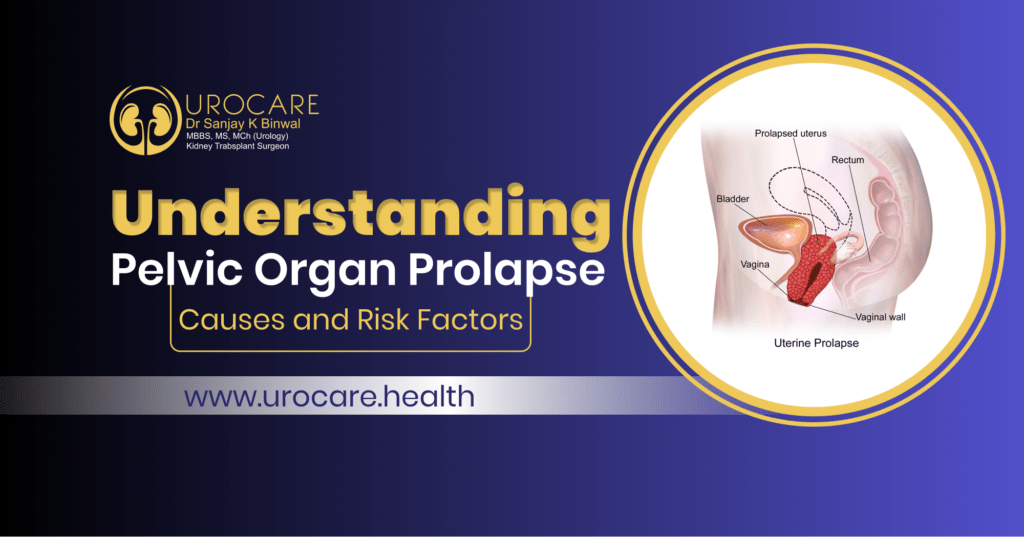Pelvic organ prolapse is a common condition that affects many women, particularly as they age. It occurs when the muscles and tissues that support the pelvic organs, including the bladder, uterus, and rectum, weaken or stretch, leading to a descent or displacement of these organs into the vaginal canal. This article aims to provide a comprehensive understanding of pelvic organ prolapse, its causes and risk factors.. By shedding light on this often-misunderstood condition, we hope to empower women to recognize the signs and symptoms, seek appropriate medical advice, and explore available prevention and treatment options. So, keep on reading till the end to know about all these details!
Causes of Pelvic Organ Prolapse:
Childbirth:
Vaginal childbirth is one of the most significant risk factors. The process of labor and delivery, especially with large babies or after a prolonged labor, can weaken and stretch the pelvic muscles and ligaments.
Aging:
As women age, the decrease in estrogen levels during menopause can lead to weakened pelvic floor muscles and connective tissue, increasing the risk of POP.
Hysterectomy:
Surgical removal of the uterus can sometimes lead to weakness in the supportive structures of the pelvic floor, as the uterus plays a role in supporting surrounding organs.
Chronic Pressure on the Abdomen:
Chronic coughing (as seen in smokers or those with lung conditions), straining during bowel movements, or consistently lifting heavy objects can put prolonged pressure on the abdomen and pelvic floor.
Obesity:
Excess body weight increases the strain and pressure on pelvic floor muscles, contributing to the development of POP.
Genetics:
A family history of pelvic organ prolapse or connective tissue disorders can be a risk factor, indicating a potential genetic predisposition to weaker pelvic tissues.
Pelvic Injury or Surgery:
Previous pelvic surgery or injuries to the pelvic area can weaken or damage the muscles and tissues supporting pelvic organs.
Neurological Conditions:
Conditions that affect the nervous system, like spinal cord injuries or multiple sclerosis, can disrupt the nerve signals that are crucial for pelvic floor muscle strength and coordination.
Physical Inactivity:
A sedentary lifestyle may contribute to weakening of the pelvic floor muscles.
Chronic Diseases and Conditions:
Certain conditions like arthritis or diabetes can affect the body’s connective tissue, making it more susceptible to prolapse.
Risk Factors of Pelvic Organ Prolapse:
Age:
As women age, the risk of POP increases, particularly among postmenopausal women. The decline in estrogen levels after menopause can weaken pelvic floor muscles and tissues.
Childbirth:
Vaginal deliveries, especially multiple or complicated births, can stretch or tear the supportive tissues of the pelvic floor, increasing the risk of prolapse later in life.
Genetics:
A family history of pelvic organ prolapse or connective tissue disorders can increase a woman’s risk, suggesting a genetic predisposition to weaker pelvic tissues.
Hysterectomy:
Surgical removal of the uterus can disrupt the natural support structures of the pelvic organs, potentially leading to prolapse of the remaining organs.
Obesity:
Excess body weight increases pressure on the pelvic floor, which can weaken muscles and tissues, elevating the risk of POP.
Chronic Coughing:
Conditions that cause chronic coughing, like asthma or smoking, can place continuous stress on pelvic muscles, leading to weakness and prolapse.
Chronic Constipation:
Regular straining during bowel movements can weaken the pelvic floor muscles and tissues over time.
Heavy Lifting:
Regularly lifting heavy objects can strain and weaken the pelvic floor muscles.
Physical Inactivity:
Lack of regular exercise can lead to weaker pelvic muscles, reducing their ability to support pelvic organs effectively.
Ethnicity:
Some studies suggest that certain ethnic groups may be at higher risk, although the relationship between ethnicity and POP is not fully understood and may be linked to other factors like genetics and lifestyle.
Understanding pelvic organ prolapse is crucial for women of all ages. By recognizing the causes, risk factors, and symptoms associated with this condition, individuals can take proactive steps to prevent or manage pelvic organ prolapse effectively. Seeking professional help and support from Dr. Sanjay K Binwal will help. It is essential for accurate diagnosis and personalized treatment plans. Remember, you are not alone in your journey, and there are resources available to assist you in regaining your pelvic health and improving your quality of life.
Read More
What Causes Pelvic Pain in Women?
What Causes Pain in Female Pelvic Area?
FAQ
1. Can pelvic organ prolapse be prevented?
While pelvic organ prolapse cannot always be prevented, there are measures that can reduce the risk. Maintaining a healthy weight, practicing pelvic floor exercises, avoiding heavy lifting, and treating chronic respiratory conditions promptly can all help minimize the chances of developing pelvic organ prolapse.
2. Are all women at risk for pelvic organ prolapse?
Pelvic organ prolapse can affect women of all ages, but certain factors increase the risk. Women who have given birth vaginally, those who are postmenopausal, individuals with a family history of pelvic organ prolapse or connective tissue disorders, and individuals engaging in activities that strain the pelvic floor are at higher risk.
3. What are the available treatment options for pelvic organ prolapse?
Treatment options for pelvic organ prolapse vary based on the severity of the condition and individual circumstances. Non-surgical options include lifestyle modifications, pelvic floor exercises, and the use of pessaries. Surgical interventions, such as vaginal or laparoscopic procedures, may be recommended for more severe cases.
4. How can I find support and resources for pelvic organ prolapse?
There are several resources available for support and information on pelvic organ prolapse. Consulting healthcare professionals, such as gynecologists or urogynecologists, can provide personalized guidance. Additionally, support groups, online forums, and reputable websites dedicated to women’s health can offer valuable insights and connect individuals with others who are experiencing or have overcome similar challenges.
